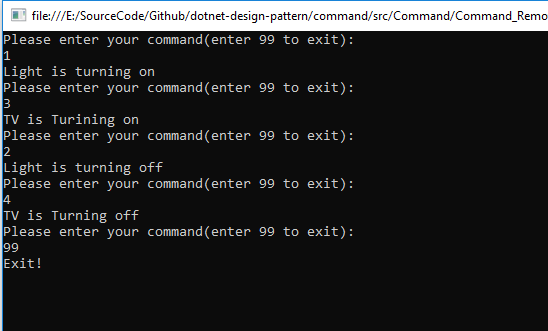模式简介
将一个请求封装为一个对象,从而使你可用不同的请求对客户进行参数化;对请求排队或记录日志,以及支持可撤销的操作。
在一些系统功能设计的时候,需要向某个对象发送请求,但是并不知道请求的接收者以及被请求的具体操作,而是在程序运行时指定具体的请求接收者。这段话比较抽象,下面通过一个实际生活中的例子来帮助大家理解。
假如我们设计了一款虚拟遥控器,用来控制智能家居电器的开关。在产品设计时我们并不知道每个按钮具体对应到哪样家居电器,而是根据用户选择,在软件运行时绑定具体的操作。这样一来,我们就需要在产品设计时将请求调用者(遥控器)与请求接受者(智能家居)解耦,使得调用者和接收者不直接交互。
结构说明

角色说明
- ICommand
命令接口,包含一个执行操作的方法。
- ConcreteCommand
具体命令类,包含一个接收者对象,并调用接收者对象以实现Execute方法。
- Receiver
接收者,知道如何执行一个操作以满足客户端传来的请求。
- Invoker
调用者,要求该命令执行这个请求。
结构代码
声明接收者Receiver,包含一个Action方法。
class Receiver
{
public void Action()
{
Console.WriteLine("called Receiver.Action()");
}
}
声明ICommand接口以及具体命令类ConcreteCommand,包含一个Receiver类型的成员。
interface ICommand
{
void Execute();
}
class ConcreteCommand : ICommand
{
private Receiver _receiver;
public ConcreteCommand(Receiver receiver)
{
_receiver = receiver;
}
public void Execute()
{
_receiver.Action();
}
}
声明调用者,提供SetCommand方法设置命令,并提供Call方法执行该命令。
class Invoker
{
private ICommand _command;
public void SetCommand(ICommand command)
{
_command = command;
}
public void Call()
{
_command.Execute();
}
}
客户端调用:
class Program
{
static void Main(string[] args)
{
Receiver receiver = new Receiver();
ConcreteCommand concreteCommand = new ConcreteCommand(receiver);
Invoker invoker = new Invoker();
invoker.SetCommand(concreteCommand);
invoker.Call();
Console.ReadLine();
}
}
输出结果:

工作原理
客户端创建一个ConcreteCommand对象并指定它的Reciever对象,再创建一个Invoker对象,存储该ConcreteCommand对象。Invoker通过ConcreteCommand的Execute方法提交请求,ConcreteCommand对象将请求传递给Receiver最终执行。
示例分析
本节我们通过命令模式来实现虚拟遥控器的示例。首先创建两个Receiver:Light和TV,它们都提供各自打开/关闭的方法。
class Light
{
public void TurnOn()
{
Console.WriteLine("Light is turning on");
}
public void TurnOff()
{
Console.WriteLine("Light is turning off");
}
}
class TV
{
public void TurnOn()
{
Console.WriteLine("TV is Turining on");
}
public void TurnOff()
{
Console.WriteLine("TV is Turning off");
}
}
创建ICommand接口,并分别实现开灯、关灯、打开电视以及关闭电视四个命令。
interface ICommand
{
void Execute();
}
class LightTurnOnCommand : ICommand
{
private Light _light;
public LightTurnOnCommand(Light light)
{
_light = light;
}
public void Execute()
{
_light.TurnOn();
}
}
class LightTurnOffCommand : ICommand
{
private Light _light;
public LightTurnOffCommand(Light light)
{
_light = light;
}
public void Execute()
{
_light.TurnOff();
}
}
class TVTurnOnCommand : ICommand
{
private TV _tv;
public TVTurnOnCommand(TV tv)
{
_tv = tv;
}
public void Execute()
{
_tv.TurnOn();
}
}
class TVTurnOffCommand : ICommand
{
private TV _tv;
public TVTurnOffCommand(TV tv)
{
_tv = tv;
}
public void Execute()
{
_tv.TurnOff();
}
}
创建遥控器RemoteController,包含一个命令集合,提供AddCommand方法向command集合添加命令。
class RemoteController
{
private List<ICommand> _commandList = new List<ICommand>();
public void AddCommand(ICommand command)
{
_commandList.Add(command);
}
public void Call(int i)
{
_commandList[i].Execute();
}
}
下面我们在客户端进行配置,首先创建一个remoteController遥控器,并绑定相应的操作,1->开灯,2->关灯,3->打开电视,4->关闭电视,99->退出遥控器。
class Program
{
static void Main(string[] args)
{
RemoteController remoteController = new RemoteController();
Light light = new Light();
LightTurnOnCommand lightTurnOn = new LightTurnOnCommand(light);
LightTurnOffCommand lightTurnOff = new LightTurnOffCommand(light);
TV tv = new TV();
TVTurnOnCommand tvTurnOn = new TVTurnOnCommand(tv);
TVTurnOffCommand tvTurnOff = new TVTurnOffCommand(tv);
remoteController.AddCommand(lightTurnOn);
remoteController.AddCommand(lightTurnOff);
remoteController.AddCommand(tvTurnOn);
remoteController.AddCommand(tvTurnOff);
int input = 0;
do
{
Console.WriteLine("Please enter your command(enter 99 to exit):");
input = Convert.ToInt32(Console.ReadLine());
if (input == 99)
{
Console.WriteLine("Exit!");
break;
}
remoteController.Call(input - 1);
} while (input != 99);
Console.ReadLine();
}
}
输出结果:

适用场景
-
将请求调用者和请求接受者解耦,使得调用者和接收者不直接交互。
-
在不同的时刻指定、排列和执行请求。
-
支持命令的撤消及恢复操作。
-
支持将一组操作组合在一起,在适当时刻执行。